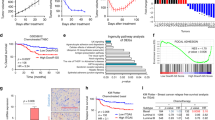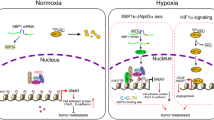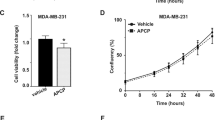Abstract
Metastasis to bone, liver and lungs is the primary cause of death in breast cancer patients. Our studies have revealed that the novel tumor suppressor Pdcd4 inhibits breast cancer cell migration and invasion in vitro. Loss of Pdcd4 in human nonmetastatic breast cancer cells increased the expression of lysyl oxidase (LOX) mRNA. LOX is a hypoxia-inducible amine oxidase, the activity of which enhances breast cancer cell invasion in vitro and in vivo. Specific inhibition of LOX activity by β-aminopropionitrile or small interfering RNA decreased the invasiveness of T47D and MCF7 breast cancer cells attenuated for Pdcd4 function. Most significantly, loss of Pdcd4 augments hypoxia induction of LOX as well. Conversely, overexpression of Pdcd4 significantly reversed the hypoxia induction of LOX expression in T47D cells attenuated for Pdcd4. However, Pdcd4 did not affect hypoxia-inducible factor-1 (HIF-1) protein expression or HIF-1-responsive element-luciferase activity in response to hypoxia, suggesting that Pdcd4 regulation of LOX occurs through an HIF-independent mechanism. Nevertheless, the loss of Pdcd4 early in cancer progression may have an important role in the increased sensitivity of cancer cells to hypoxia through increased LOX activity and concomitant enhanced invasiveness.
This is a preview of subscription content, access via your institution
Access options
Subscribe to this journal
Receive 50 print issues and online access
$259.00 per year
only $5.18 per issue
Buy this article
- Purchase on Springer Link
- Instant access to full article PDF
Prices may be subject to local taxes which are calculated during checkout






Similar content being viewed by others
References
Arsham AM, Plas DR, Thompson CB, Simon MC . (2004). Akt and hypoxia-inducible factor-1 independently enhance tumor growth and angiogenesis. Cancer Res 64: 3500–3507.
Asangani IA, Rasheed SA, Nikolova DA, Leupold JH, Colburn NH, Post S et al. (2008). MicroRNA-21 (miR-21) post-transcriptionally downregulates tumor suppressor Pdcd4 and stimulates invasion, intravasation and metastasis in colorectal cancer. Oncogene 27: 2128–2136.
Atsawasuwan P, Mochida Y, Katafuchi M, Kaku M, Fong KS, Csiszar K et al. (2008). Lysyl oxidase binds transforming growth factor-beta and regulates its signaling via amine oxidase activity. J Biol Chem 283: 34229–34240.
Bedogni B, Welford SM, Cassarino DS, Nickoloff BJ, Giaccia AJ, Powell MB . (2005). The hypoxic microenvironment of the skin contributes to Akt-mediated melanocyte transformation. Cancer Cell 8: 443–454.
Bitomsky N, Bohm M, Klempnauer KH . (2004). Transformation suppressor protein Pdcd4 interferes with JNK-mediated phosphorylation of c-Jun and recruitment of the coactivator p300 by c-Jun. Oncogene 23: 7484–7493.
Chen HH, Su WC, Lin PW, Guo HR, Lee WY . (2007). Hypoxia-inducible factor-1alpha correlates with MET and metastasis in node-negative breast cancer. Breast Cancer Res Treat 103: 167–175.
Chen Y, Knosel T, Kristiansen G, Pietas A, Garber ME, Matsuhashi S et al. (2003). Loss of PDCD4 expression in human lung cancer correlates with tumour progression and prognosis. J Pathol 200: 640–646.
Cmarik JL, Min H, Hegamyer G, Zhan S, Kulesz-Martin M, Yoshinaga H et al. (1999). Differentially expressed protein Pdcd4 inhibits tumor promoter-induced neoplastic transformation. Proc Natl Acad Sci USA 96: 14037–14042.
Csiszar K, Entersz I, Trackman PC, Samid D, Boyd CD . (1996). Functional analysis of the promoter and first intron of the human lysyl oxidase gene. Mol Biol Rep 23: 97–108.
Davis BN, Hilyard AC, Lagna G, Hata A . (2008). SMAD proteins control DROSHA-mediated microRNA maturation. Nature 454: 56–61.
Denko NC, Fontana LA, Hudson KM, Sutphin PD, Raychaudhuri S, Altman R et al. (2003). Investigating hypoxic tumor physiology through gene expression patterns. Oncogene 22: 5907–5914.
Dorrello NV, Peschiaroli A, Guardavaccaro D, Colburn NH, Sherman NE, Pagano M . (2006). S6K1- and betaTRCP-mediated degradation of PDCD4 promotes protein translation and cell growth. Science 314: 467–471.
Erler JT, Bennewith KL, Nicolau M, Dornhofer N, Kong C, Le QT et al. (2006). Lysyl oxidase is essential for hypoxia-induced metastasis. Nature 440: 1222–1226.
Erler JT, Giaccia AJ . (2006). Lysyl oxidase mediates hypoxic control of metastasis. Cancer Res 66: 10238–10241.
Goke R, Barth P, Schmidt A, Samans B, Lankat-Buttgereit B . (2004a). Programmed cell death protein 4 suppresses CDK1/cdc2 via induction of p21(Waf1/Cip1). Am J Physiol Cell Physiol 287: C1541–C1546.
Goke R, Gregel C, Goke A, Arnold R, Schmidt H, Lankat-Buttgereit B . (2004b). Programmed cell death protein 4 (PDCD4) acts as a tumor suppressor in neuroendocrine tumor cells. Ann N Y Acad Sci 1014: 220–221.
Ivan M, Harris AL, Martelli F, Kulshreshtha R . (2008). Hypoxia response and microRNAs: no longer two separate worlds. J Cell Mol Med 12: 1426–1431.
Ivanov SV, Kuzmin I, Wei MH, Pack S, Geil L, Johnson BE et al. (1998). Down-regulation of transmembrane carbonic anhydrases in renal cell carcinoma cell lines by wild-type von Hippel-Lindau transgenes. Proc Natl Acad Sci USA 95: 12596–12601.
Jansen AP, Camalier CE, Colburn NH . (2005). Epidermal expression of the translation inhibitor programmed cell death 4 suppresses tumorigenesis. Cancer Res 65: 6034–6041.
Jansen AP, Camalier CE, Stark C, Colburn NH . (2004). Characterization of programmed cell death 4 in multiple human cancers reveals a novel enhancer of drug sensitivity. Mol Cancer Ther 3: 103–110.
Jeay S, Pianetti S, Kagan HM, Sonenshein GE . (2003). Lysyl oxidase inhibits ras-mediated transformation by preventing activation of NF-kappa B. Mol Cell Biol 23: 2251–2263.
Kagan HM, Li W . (2003). Lysyl oxidase: properties, specificity, and biological roles inside and outside of the cell. J Cell Biochem 88: 660–672.
Kagan HM, Trackman PC . (1991). Properties and function of lysyl oxidase. Am J Respir Cell Mol Biol 5: 206–210.
Kang Y . (2005). Functional genomic analysis of cancer metastasis: biologic insights and clinical implications. Expert Rev Mol Diagn 5: 385–395.
Kirkegaard T, Witton CJ, McGlynn LM, Tovey SM, Dunne B, Lyon A et al. (2005). AKT activation predicts outcome in breast cancer patients treated with tamoxifen. J Pathol 207: 139–146.
Kirschmann DA, Seftor EA, Fong SF, Nieva DR, Sullivan CM, Edwards EM et al. (2002). A molecular role for lysyl oxidase in breast cancer invasion. Cancer Res 62: 4478–4483.
Kronblad A, Jirstrom K, Ryden L, Nordenskjold B, Landberg G . (2006). Hypoxia inducible factor-1alpha is a prognostic marker in premenopausal patients with intermediate to highly differentiated breast cancer but not a predictive marker for tamoxifen response. Int J Cancer 118: 2609–2616.
Kulshreshtha R, Davuluri RV, Calin GA, Ivan M . (2008). A microRNA component of the hypoxic response. Cell Death Differ 15: 667–671.
Kulshreshtha R, Ferracin M, Wojcik SE, Garzon R, Alder H, Agosto-Perez FJ et al. (2007). A microRNA signature of hypoxia. Mol Cell Biol 27: 1859–1867.
LaRonde-LeBlanc N, Santhanam AN, Baker AR, Wlodawer A, Colburn NH . (2007). Structural basis for inhibition of translation by the tumor suppressor Pdcd4. Mol Cell Biol 27: 147–156.
Leupold JH, Yang HS, Colburn NH, Asangani I, Post S, Allgayer H . (2007). Tumor suppressor Pdcd4 inhibits invasion/intravasation and regulates urokinase receptor (u-PAR) gene expression via Sp-transcription factors. Oncogene 26: 4550–4562.
Li T, Li D, Sha J, Sun P, Huang Y . (2009). MicroRNA-21 directly targets MARCKS and promotes apoptosis resistance and invasion in prostate cancer cells. Biochem Biophys Res Commun 383: 280–285.
Li YM, Zhou BP, Deng J, Pan Y, Hay N, Hung MC . (2005). A hypoxia-independent hypoxia-inducible factor-1 activation pathway induced by phosphatidylinositol-3 kinase/Akt in HER2 overexpressing cells. Cancer Res 65: 3257–3263.
Lu Z, Liu M, Stribinskis V, Klinge CM, Ramos KS, Colburn NH et al. (2008). MicroRNA-21 promotes cell transformation by targeting the programmed cell death 4 gene. Oncogene 27: 4373–4379.
Lundgren K, Holm C, Landberg G . (2007). Hypoxia and breast cancer: prognostic and therapeutic implications. Cell Mol Life Sci 64: 3233–3247.
Melillo G, Sausville EA, Cloud K, Lahusen T, Varesio L, Senderowicz AM . (1999). Flavopiridol, a protein kinase inhibitor, down-regulates hypoxic induction of vascular endothelial growth factor expression in human monocytes. Cancer Res 59: 5433–5437.
Min C, Kirsch KH, Zhao Y, Jeay S, Palamakumbura AH, Trackman PC et al. (2007). The tumor suppressor activity of the lysyl oxidase propeptide reverses the invasive phenotype of Her-2/neu-driven breast cancer. Cancer Res 67: 1105–1112.
Mudduluru G, Medved F, Grobholz R, Jost C, Gruber A, Leupold JH et al. (2007). Loss of programmed cell death 4 expression marks adenoma-carcinoma transition, correlates inversely with phosphorylated protein kinase B, and is an independent prognostic factor in resected colorectal cancer. Cancer 110: 1697–1707.
Nieves-Alicea R, Colburn NH, Simeone AM, Tari AM . (2008). Programmed cell death 4 inhibits breast cancer cell invasion by increasing tissue inhibitor of metalloproteinases-2 expression. Breast Cancer Res Treat 114: 203–209.
Pastorek J, Pastorekova S, Callebaut I, Mornon JP, Zelnik V, Opavsky R et al. (1994). Cloning and characterization of MN, a human tumor-associated protein with a domain homologous to carbonic anhydrase and a putative helix-loop-helix DNA binding segment. Oncogene 9: 2877–2888.
Payne SL, Fogelgren B, Hess AR, Seftor EA, Wiley EL, Fong SF et al. (2005). Lysyl oxidase regulates breast cancer cell migration and adhesion through a hydrogen peroxide-mediated mechanism. Cancer Res 65: 11429–11436.
Payne SL, Hendrix MJ, Kirschmann DA . (2007). Paradoxical roles for lysyl oxidases in cancer—a prospect. J Cell Biochem 101: 1338–1354.
Postovit LM, Abbott DE, Payne SL, Wheaton WW, Margaryan NV, Sullivan R et al. (2008). Hypoxia/reoxygenation: a dynamic regulator of lysyl oxidase-facilitated breast cancer migration. J Cell Biochem 103: 1369–1378.
Rucker RB, Kosonen T, Clegg MS, Mitchell AE, Rucker BR, Uriu-Hare JY et al. (1998). Copper, lysyl oxidase, and extracellular matrix protein cross-linking. Am J Clin Nutr 67: 996S–1002S.
Schindl M, Schoppmann SF, Samonigg H, Hausmaninger H, Kwasny W, Gnant M et al. (2002). Overexpression of hypoxia-inducible factor 1alpha is associated with an unfavorable prognosis in lymph node-positive breast cancer. Clin Cancer Res 8: 1831–1837.
Schmid T, Jansen AP, Baker AR, Hegamyer G, Hagan JP, Colburn NH . (2008). Translation inhibitor Pdcd4 is targeted for degradation during tumor promotion. Cancer Res 68: 1254–1260.
Schmitz KJ, Otterbach F, Callies R, Levkau B, Holscher M, Hoffmann O et al. (2004). Prognostic relevance of activated Akt kinase in node-negative breast cancer: a clinicopathological study of 99 cases. Mod Pathol 17: 15–21.
Smith-Mungo LI, Kagan HM . (1998). Lysyl oxidase: properties, regulation and multiple functions in biology. Matrix Biol 16: 387–398.
Tan RS, Taniguchi T, Harada H . (1996). Identification of the lysyl oxidase gene as target of the antioncogenic transcription factor, IRF-1, and its possible role in tumor suppression. Cancer Res 56: 2417–2421.
van der Groep P, Bouter A, Menko FH, van der Wall E, van Diest PJ . (2008). High frequency of HIF-1alpha overexpression in BRCA1 related breast cancer reast. Cancer Res Treat 111: 475–480.
Vleugel MM, Greijer AE, Shvarts A, van der Groep P, van Berkel M, Aarbodem Y et al. (2005). Differential prognostic impact of hypoxia induced and diffuse HIF-1alpha expression in invasive breast cancer. J Clin Pathol 58: 172–177.
Waters LC, Veverka V, Bohm M, Schmedt T, Choong PT, Muskett FW et al. (2007). Structure of the C-terminal MA-3 domain of the tumour suppressor protein Pdcd4 and characterization of its interaction with eIF4A. Oncogene 26: 4941–4950.
Wen YH, Shi X, Chiriboga L, Matsahashi S, Yee H, Afonja O . (2007). Alterations in the expression of PDCD4 in ductal carcinoma of the breast. Oncol Rep 18: 1387–1393.
Yagata H, Harigaya K, Suzuki M, Nagashima T, Hashimoto H, Ishii G et al. (2003). Comedonecrosis is an unfavorable marker in node-negative invasive breast carcinoma. Pathol Int 53: 501–506.
Yang HS, Cho MH, Zakowicz H, Hegamyer G, Sonenberg N, Colburn NH . (2004). A novel function of the MA-3 domains in transformation and translation suppressor Pdcd4 is essential for its binding to eukaryotic translation initiation factor 4A. Mol Cell Biol 24: 3894–3906.
Yang HS, Jansen AP, Komar AA, Zheng X, Merrick WC, Costes S et al. (2003a). The transformation suppressor Pdcd4 is a novel eukaryotic translation initiation factor 4A binding protein that inhibits translation. Mol Cell Biol 23: 26–37.
Yang HS, Jansen AP, Nair R, Shibahara K, Verma AK, Cmarik JL et al. (2001). A novel transformation suppressor, Pdcd4, inhibits AP-1 transactivation but not NF-kappaB or ODC transactivation. Oncogene 20: 669–676.
Yang HS, Knies JL, Stark C, Colburn NH . (2003b). Pdcd4 suppresses tumor phenotype in JB6 cells by inhibiting AP-1 transactivation. Oncogene 22: 3712–3720.
Yang HS, Matthews CP, Clair T, Wang Q, Baker AR, Li CC et al. (2006). Tumorigenesis suppressor Pdcd4 down-regulates mitogen-activated protein kinase kinase kinase kinase 1 expression to suppress colon carcinoma cell invasion. Mol Cell Biol 26: 1297–1306.
Zakowicz H, Yang HS, Stark C, Wlodawer A, Laronde-Leblanc N, Colburn NH . (2005). Mutational analysis of the DEAD-box RNA helicase eIF4AII characterizes its interaction with transformation suppressor Pdcd4 and eIF4GI. RNA 11: 261–274.
Zhang H, Ozaki I, Mizuta T, Hamajima H, Yasutake T, Eguchi Y et al. (2006). Involvement of programmed cell death 4 in transforming growth factor-beta1-induced apoptosis in human hepatocellular carcinoma. Oncogene 25: 6101–6112.
Zhu S, Wu H, Wu F, Nie D, Sheng S, Mo YY . (2008). MicroRNA-21 targets tumor suppressor genes in invasion and metastasis. Cell Res 18: 350–359.
Acknowledgements
We thank Drs Giovanni Melillo and Annamaria Rapisarda (Tumor Hypoxia Laboratory, NCI-Frederick) for helpful suggestions and for the use of reagents and hypoxia chambers. We also thank members of the Gene Regulation Section, Laboratory of Cancer Prevention, for helpful discussions. This research was supported by the Intramural Research Program of the NIH, National Cancer Institute, Center for Cancer Research.
Author information
Authors and Affiliations
Corresponding author
Ethics declarations
Competing interests
The authors declare no conflict of interest.
Additional information
Supplementary Information accompanies the paper on the Oncogene website
Rights and permissions
About this article
Cite this article
Santhanam, A., Baker, A., Hegamyer, G. et al. Pdcd4 repression of lysyl oxidase inhibits hypoxia-induced breast cancer cell invasion. Oncogene 29, 3921–3932 (2010). https://doi.org/10.1038/onc.2010.158
Received:
Revised:
Accepted:
Published:
Issue Date:
DOI: https://doi.org/10.1038/onc.2010.158
Keywords
This article is cited by
-
PDCD4 controls the G1/S-phase transition in a telomerase-immortalized epithelial cell line and affects the expression level and translation of multiple mRNAs
Scientific Reports (2020)
-
Nuclear PDCD4 Expression Defines a Subset of Luminal B-Like Breast Cancers with Good Prognosis
Hormones and Cancer (2020)
-
TUG1 confers cisplatin resistance in esophageal squamous cell carcinoma by epigenetically suppressing PDCD4 expression via EZH2
Cell & Bioscience (2018)
-
Tumor suppressor Pdcd4 attenuates Sin1 translation to inhibit invasion in colon carcinoma
Oncogene (2017)
-
miR-93 functions as an oncomiR for the downregulation of PDCD4 in gastric carcinoma
Scientific Reports (2016)



